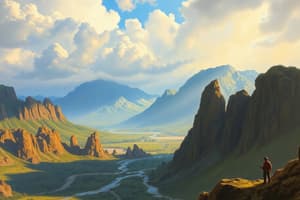Podcast
Questions and Answers
Which fossil fuel accounts for the largest percentage of electricity production in the U.S.?
Which fossil fuel accounts for the largest percentage of electricity production in the U.S.?
- Coal (correct)
- Hydroelectric
- Natural Gas
- Oil
Natural gas is heavier than oil.
Natural gas is heavier than oil.
False (B)
What is a primary use of oil?
What is a primary use of oil?
Gasoline
Fossil fuels are considered a __________ resource because they take millions of years to form.
Fossil fuels are considered a __________ resource because they take millions of years to form.
Match the fossil fuels with their uses:
Match the fossil fuels with their uses:
Which of the following correctly describes a process in the rock cycle?
Which of the following correctly describes a process in the rock cycle?
Plate tectonics have no effect on the rock cycle.
Plate tectonics have no effect on the rock cycle.
What are the three main types of rocks involved in the rock cycle?
What are the three main types of rocks involved in the rock cycle?
Rocks can be transformed into metamorphic rock through __________ and pressure.
Rocks can be transformed into metamorphic rock through __________ and pressure.
Match the following processes with the correct rock type:
Match the following processes with the correct rock type:
Flashcards
Rock Cycle
Rock Cycle
The continuous process where rocks change from one type to another over millions of years. It involves melting, cooling, weathering, erosion, and heat and pressure.
Igneous Rocks
Igneous Rocks
Rocks formed from the cooling and hardening of molten rock (magma or lava).
Sedimentary Rocks
Sedimentary Rocks
Rocks formed from the compaction and cementation of sediments (small pieces of other rocks, minerals, and organic materials).
Metamorphic Rocks
Metamorphic Rocks
Signup and view all the flashcards
Plate Tectonics and the Rock Cycle
Plate Tectonics and the Rock Cycle
Signup and view all the flashcards
Fossil Fuel
Fossil Fuel
Signup and view all the flashcards
Coal
Coal
Signup and view all the flashcards
Oil
Oil
Signup and view all the flashcards
Natural Gas
Natural Gas
Signup and view all the flashcards
Fossil Fuels are Non-Renewable
Fossil Fuels are Non-Renewable
Signup and view all the flashcards




